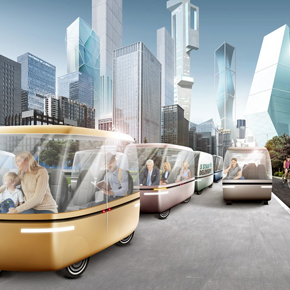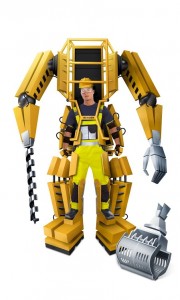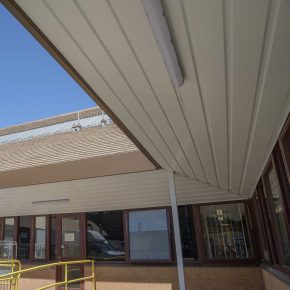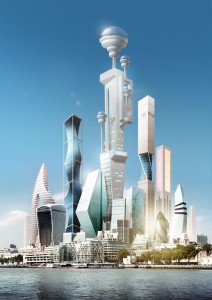
Back to the Future of Construction: Space ports, exoskeletons and virtual reality
To celebrate the 30th anniversary of Back to the Future, futurologist Ian Pearson has taken a trip a further 30 years down the line to predict what the world of construction may look like in 2045.
2045: Constructing the Future predicts a world of superhuman AI; half-human, half-machine exoskeletons and self-driving transportation ‘pods’.
Constructing the Future
Manufactured using ultra-strong, carbon-based materials, his report predicts that buildings will utilise advanced AI to adopt their very own personalities.
‘Smart buildings’ will collect and process sensor data, and help maintain all the various infrastructure and human comfort systems within the structure.
Advances in 3D printing will allow for the rapid construction of basic structures, and the extensive use of carbon nanotubes and graphene to reinforce building materials will enable stronger, lighter and taller buildings.
The tallest skyscrapers – up to 30 km tall – will act as mini-cities, many of which will house their very own space ports as space travel becomes a popular method of transportation.
Virtual architecture
As the use of augmented reality becomes more widespread, Ian suggests that it will greatly impact the visual appearance of our surroundings.
By 2045 we could see most buildings become windowless, instead featuring a simple planar surface, with more intricate details projected through the use of augmented reality. This way a cheap building can appear exactly the same in AR as an expensive one.
Virtual reality will also introduce marketing campaigns, artificial plants and animals into our surroundings to stimulate the visual environment.
Half human, half machine
The report speculates that most construction work will be completed with the use of super-strength exoskeletons.
Exoskeletons will convert builders into ‘transfomer-like’ workers, capable of lifting heavy loads and attaching special equipment to complete difficult tasks.
The heavy machines will work with a variety of attachments, including shape shifting technologies to help cut through materials, making cleaner edges and surfaces.
Augmented reality will also be utilised to allow the builders to see exactly where things should go and what the finished project is meant to look like to ensure the job is completed properly.
Transportation pods
Self-driving cars, similar to those currently being developed by Google, will be used universally by 2045 and almost entirely fleet managed, with private ownership rendered obsolete.
The electric vehicles will greatly reduce financial costs, pollution, congestion and accidents.
Vehicles, or ‘pods’, will be developed with the ability to share energy preserves, reducing their environmental impact and the need for external power sources.
Whilst these pods won’t hover, in special high-impact areas some vehicles may levitate on magnetic cushions, requiring partly metal road surfaces.
Back to the Future
Ian’s report concludes by suggesting that construction in 2045 will still share many of the same goals the industry faces today. Whilst automation and robots will be the biggest changes, the continued development of 3D printing and augmented reality will also have a significant effect on the way the industry operates.
Whilst we’re still waiting on some of the things promised in Back to the Future, the 2045: Constructing the Future report gives us plenty more to look forward to in the next three decades of construction.
Read 2045: Constructing the Future in full here
Latest news

26th April 2024
Alumasc Skyline and Rainwater package specified at Weston-super-Mare Hospital
A package of products from Alumasc Water Management Solutions (AWMS) has been used for the external refurbishment of the roofline at Weston General Hospital in Weston-Super-Mare.
Posted in Aluminium Products, Articles, Building Industry News, Building Products & Structures, Building Services, Building Systems, Case Studies, Cladding, Drainage Services, Drainage, Guttering, Soffits & Fascias, Fascias, Restoration & Refurbishment, Retrofit & Renovation, Roofs, Walls
26th April 2024
Hush Acoustics optimises fleet operations by securing FORS Gold accreditation
Hush Acoustics has invested in the safety and sustainability of its commercial vehicle fleet by achieving Gold status in the Fleet Operator Recognition Scheme (FORS).
Posted in Acoustics, Noise & Vibration Control, Articles, Building Industry News, Building Products & Structures, Building Regulations & Accreditations, Building Services, Ceilings, Facility Management & Building Services, Floors, Health & Safety, Insulation, Restoration & Refurbishment, Retrofit & Renovation, Site Preparation, Sustainability & Energy Efficiency, Walls, Waste Management & Recycling
26th April 2024
Safeguard Europe: Penetrating damp - how to diagnose the damage
As Safeguard gets ready to deliver another informative session of one of its most popular webinars, the company outlines some of the most common reasons for rain penetration through brickwork.
Posted in Articles, Bricks & Blocks, Building Industry Events, Building Industry News, Building Products & Structures, Building Services, Continuing Professional Development (CPD's), Damp & Waterproofing, Facility Management & Building Services, Information Technology, Posts, Render, Restoration & Refurbishment, Retrofit & Renovation, Seminars, Training, Walls
25th April 2024
ADSA: Competence Initiative Makes Progress
The Joint Competency Initiative (JCI), in which the Automatic Door Suppliers Association (ADSA) is involved, is finalising its first framework for installers within the door, gates and shutter industry.
Posted in Access Control & Door Entry Systems, Architectural Ironmongery, Articles, Building Associations & Institutes, Building Industry Events, Building Industry News, Building Products & Structures, Building Regulations & Accreditations, Building Services, Continuing Professional Development (CPD's), Doors, Facility Management & Building Services, Health & Safety, Innovations & New Products, Publications, Research & Materials Testing, Restoration & Refurbishment, Retrofit & Renovation, Security and Fire Protection, Site Preparation
 Sign up:
Sign up: 